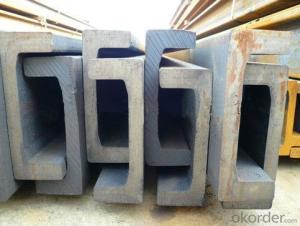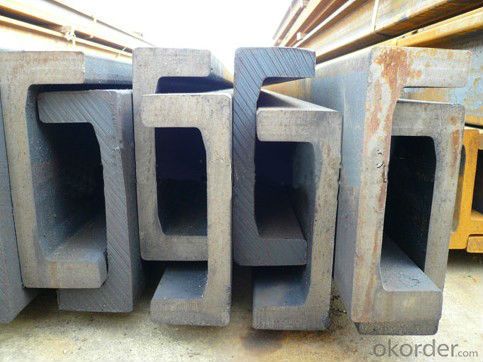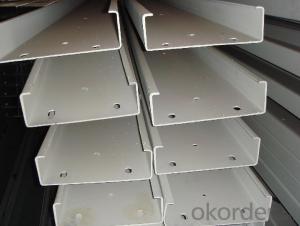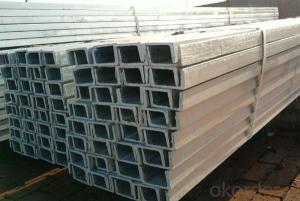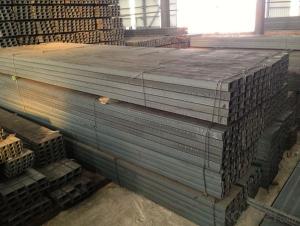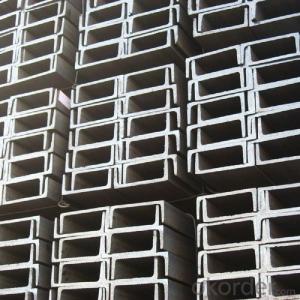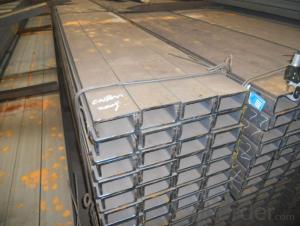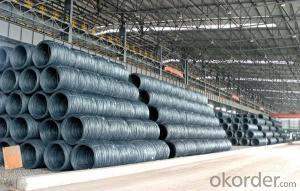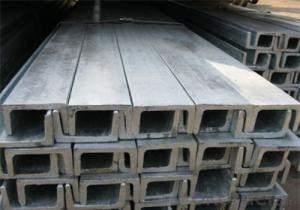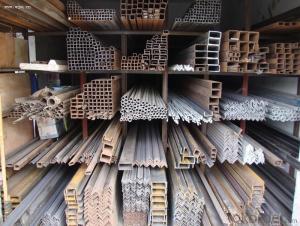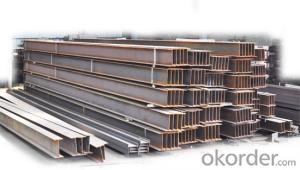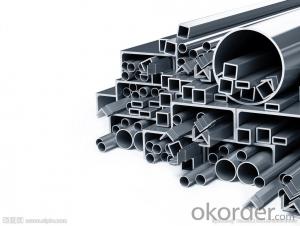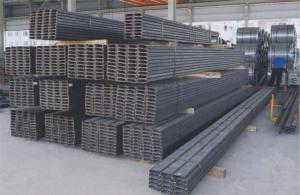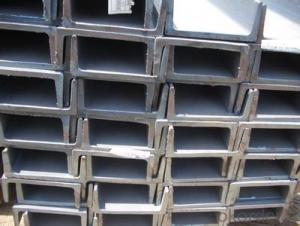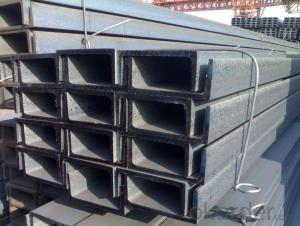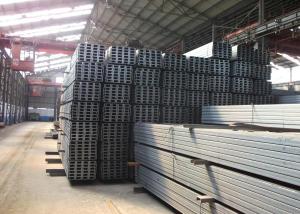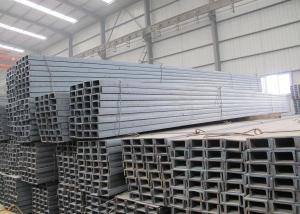Hot Rolled Channel Steel, Carbon Mild Structural Steel U Channel
- Loading Port:
- Shanghai
- Payment Terms:
- TT OR LC
- Min Order Qty:
- 2000 PCS
- Supply Capability:
- 30000 PCS/month
OKorder Service Pledge
OKorder Financial Service
You Might Also Like
JIS Standard Hot Rolled Channel Steel, Carbon Mild Sstructural Steel U Channel Details
| Standard: | AISI,ASTM,BS,DIN,GB,JIS | Dimensions: | 50*37*4.5mm-400*104*14.5mm | Grade: | carbon steel |
| Place of Origin: | China (Mainland) | Perforated Or Not: | Not Perforated | Model Number: | 50*37*4.5mm-400*104*14.5mm |
| Shape: | U Channel | Application: | Construction |
Packaging & Delivery
| Packaging Detail: | in bundle and load by container or bulk vessel |
| Delivery Detail: | within 30 days after receiving deposit or original L/C |
JIS Standard Hot Rolled Channel Steel, Carbon Mild Sstructural Steel U Channel Specification
JIS Standard Channel Steel Bar | ||||
H(mm) | B(mm) | T1(mm) | T2(mm) | Kg/m |
75 | 40 | 3.8 | 7.0 | 5.30 |
75 | 40 | 4.0 | 7.0 | 5.60 |
75 | 40 | 4.5 | 7.0 | 5.85 |
75 | 40 | 5.0 | 7.0 | 6.92 |
76 | 38 | 5.1 | 6.8 | 6.70 |
100 | 50 | 3.8 | 6.0 | 7.30 |
100 | 50 | 4.2 | 6.0 | 8.03 |
100 | 50 | 4.5 | 7.5 | 8.97 |
100 | 50 | 5.0 | 7.5 | 9.36 |
102 | 51 | 6.1 | 7.6 | 10.42 |
125 | 65 | 5.2 | 6.8 | 11.66 |
125 | 65 | 5.3 | 6.8 | 12.17 |
125 | 65 | 5.5 | 8.0 | 12.91 |
125 | 65 | 6.0 | 8.0 | 13.40 |
127 | 64 | 6.4 | 9.2 | 14.9 |
150 | 75 | 5.5 | 7.3 | 14.66 |
150 | 75 | 5.7 | 10.0 | 16.71 |
150 | 75 | 6.5 | 10.0 | 18.60 |
150 | 75 | 9.0 | 12.5 | 24.00 |
152 | 76 | 6.4 | 9.0 | 17.90 |
JIS Standard Hot Rolled Channel Steel, Carbon Mild Sstructural Steel U Channel Pictures
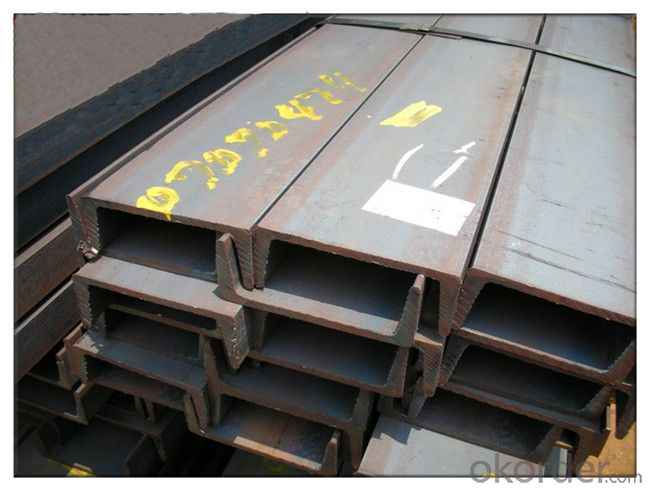
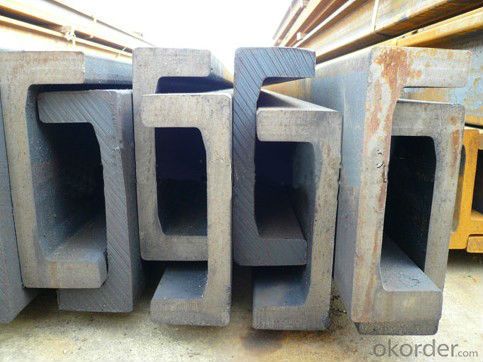
- Q: Can steel channels be used for supporting curtain wall systems?
- Yes, steel channels can be used for supporting curtain wall systems. Steel channels are commonly used for structural support in construction and can provide the necessary strength and stability required to support the weight of curtain wall systems. Additionally, steel channels can be easily customized and fabricated to accommodate the specific design requirements of the curtain wall system. They can be attached to the building structure and provide a secure anchor point for the curtain wall system, ensuring its stability and performance. Overall, steel channels are a popular choice for supporting curtain wall systems due to their strength, durability, and versatility.
- Q: How do steel channels perform in high-temperature environments?
- Steel channels perform well in high-temperature environments due to their excellent heat resistance properties. Steel is known for its high melting point and strength, allowing the channels to maintain their structural integrity even under extreme temperatures. Additionally, steel has low thermal expansion, minimizing the risk of warping or distortion. Overall, steel channels are a reliable choice for applications requiring stability and durability in high-temperature settings.
- Q: How do steel channels contribute to the overall sustainability of a building?
- Steel channels contribute to the overall sustainability of a building in several ways. Firstly, they provide structural support, ensuring the building's longevity and reducing the need for frequent repairs or replacements. Additionally, steel channels can be made from recycled materials, reducing the environmental impact of manufacturing processes. Their durability also minimizes waste generation over time. Furthermore, steel is a highly recyclable material, allowing for easy and efficient reuse at the end of a building's life cycle. Overall, steel channels help create sustainable and resilient buildings by promoting resource efficiency, reducing waste, and supporting long-term durability.
- Q: Can steel channels be used for catwalks?
- Yes, steel channels can be used for catwalks.
- Q: Are steel channels suitable for high-rise buildings?
- High-rise buildings can indeed utilize steel channels as they possess the necessary strength and versatility. Commonly referred to as C-channels or U-channels, steel channels serve as integral components in the construction of tall structures. These channels exhibit exceptional load-bearing capacity and structural stability, making them ideal for supporting the weight of multi-story buildings. Their ability to withstand heavy vertical loads enables efficient distribution throughout the structure. Moreover, steel channels are known for their resistance to bending and torsion, ensuring that high-rise buildings maintain their structural integrity even in the face of extreme circumstances like earthquakes or strong winds. Another advantage of steel channels lies in their ease of fabrication and installation, simplifying the construction process. They are available in various sizes and shapes, allowing for customized designs that cater to the specific requirements of high-rise buildings. Additionally, steel channels can be effortlessly connected to other structural elements, such as beams or columns, establishing a robust and enduring framework for the entire edifice. Furthermore, steel channels possess a high strength-to-weight ratio, enabling them to provide substantial structural support while keeping the overall weight of the building relatively low. This proves particularly advantageous for tall structures as it reduces the overall load on the foundation and lowers construction expenses. Furthermore, the utilization of steel channels permits flexible and adaptable designs, empowering architects and engineers to create innovative and efficient high-rise structures. In conclusion, steel channels are exceptionally well-suited for high-rise buildings due to their strength, structural stability, ease of fabrication and installation, as well as their capacity to withstand extreme conditions. Their versatility and efficiency make them the preferred choice for constructing high-rise buildings that are safe, durable, and aesthetically pleasing.
- Q: What are the sustainability benefits of using steel channels?
- There are several sustainability benefits associated with the use of steel channels. Firstly, steel is one of the most recycled materials in the world. This means that using steel channels helps to reduce the demand for new raw materials and the associated energy consumption and greenhouse gas emissions that come with their extraction and production. By opting for steel channels, we can contribute to a circular economy and minimize waste. Furthermore, steel is known for its durability and longevity. Steel channels have a high resistance to corrosion and can withstand harsh environmental conditions, making them a sustainable choice for various applications. Their durability reduces the need for frequent replacements, saving resources and reducing waste generation. In addition, steel is an energy-efficient material. The production of steel channels requires less energy compared to other construction materials, such as concrete or aluminum. This energy efficiency translates into lower carbon emissions during the manufacturing process, contributing to the overall reduction of the carbon footprint. Moreover, steel channels can be easily repurposed and reused in different applications. This flexibility allows for the adaptability and versatility of the material, minimizing the need for new production and reducing the environmental impact. Steel channels can be recycled and transformed into new steel products, further extending their lifespan and reducing the demand for virgin materials. Lastly, steel channels are lightweight compared to other construction materials. This characteristic reduces transportation costs and energy consumption during shipping, as well as the associated emissions. Choosing steel channels can contribute to a more sustainable supply chain by reducing the carbon emissions and environmental impact associated with logistics. In conclusion, the sustainability benefits of using steel channels include its high recyclability, durability, energy efficiency, adaptability, and lightweight nature. By opting for steel channels, we can contribute to a more sustainable and environmentally friendly construction industry.
- Q: What is the difference between hot-rolled and cold-formed steel channels?
- The main difference between hot-rolled and cold-formed steel channels lies in the manufacturing process. Hot-rolled steel channels are formed by heating the steel billet to high temperatures and then rolling it into the desired shape. This method results in a more uniform grain structure and higher strength compared to cold-formed steel channels. On the other hand, cold-formed steel channels are created by bending or rolling steel sheets at room temperature. This process is more cost-effective and allows for greater design flexibility, but the resulting channels may have a less consistent grain structure and slightly lower strength.
- Q: Can steel channels be used in solar panel installations?
- Yes, steel channels can be used in solar panel installations. Steel channels, also known as steel C channels or steel U channels, are commonly used in construction and industrial applications for their strength, durability, and versatility. When it comes to solar panel installations, steel channels can be used as support structures for mounting solar panels on rooftops or in ground-mounted systems. Steel channels provide a stable and robust framework that can withstand the weight of solar panels and withstand various weather conditions. They can be easily customized and fabricated to meet specific installation requirements, such as the size and angle of the solar panels. Additionally, steel channels can be galvanized or coated to provide corrosion resistance, ensuring the longevity of the solar panel installation. Furthermore, steel channels offer flexibility in terms of design and layout. They can be easily integrated with other mounting systems and components, such as rails, brackets, and clamps, allowing for efficient and secure solar panel installations. The adaptability of steel channels makes them suitable for both residential and commercial solar panel projects. In conclusion, steel channels are a viable option for solar panel installations due to their strength, durability, versatility, and compatibility with other mounting systems. They provide a solid foundation for mounting solar panels, ensuring a stable and efficient solar energy system.
- Q: What is the cost of steel channels compared to other construction materials?
- The cost of steel channels compared to other construction materials can vary depending on factors such as the size and quality of the channels, as well as the current market conditions. However, in general, steel channels tend to be more expensive than materials like wood or aluminum, but they offer benefits such as durability and strength that make them a preferred choice for certain construction projects.
- Q: What does "channel 160*60*20*2.5" mean in steel roof trusses? What is the specific weight?
- Steel structure is mainly made of steel material, and it is one of the main types of building structure. The structure is mainly composed of steel beams and steel plates, such as steel beams, steel columns, steel trusses and so on. Each component or component is usually connected with welds, bolts or rivets. Because of its light weight and simple construction, it is widely used in large factories, stadiums, super high-rise and other fields.
Send your message to us
Hot Rolled Channel Steel, Carbon Mild Structural Steel U Channel
- Loading Port:
- Shanghai
- Payment Terms:
- TT OR LC
- Min Order Qty:
- 2000 PCS
- Supply Capability:
- 30000 PCS/month
OKorder Service Pledge
OKorder Financial Service
Similar products
Hot products
Hot Searches
Related keywords
